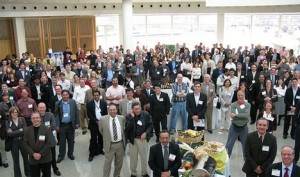 Recently, we have seen increasing investor interest in the Finnish cleantech market, which closed a total of €40-50m worth of investments in Q3 including those in companies such as European Batteries, a large scale lithium ion battery manufacturer, Nokia spin-off There Corporation, a sub/smart metering technology provider, and Preseco, a waste-to-energy company. Investments in Finnish clean technologies represented around 50% of cleantech VC investments in the Nordics, which closed a total of €100m worth of investments (source: Cleantech Scandinavia). Examples of Nordic investments are in companies like Danish biomass fuelled engine technology provides Stirling, Swedish nanowire semiconductor LED developer Glo (a link to release), Norwegian solar cell manufacturer Innotech Solar and EV company Think Global.
Recently, we have seen increasing investor interest in the Finnish cleantech market, which closed a total of €40-50m worth of investments in Q3 including those in companies such as European Batteries, a large scale lithium ion battery manufacturer, Nokia spin-off There Corporation, a sub/smart metering technology provider, and Preseco, a waste-to-energy company. Investments in Finnish clean technologies represented around 50% of cleantech VC investments in the Nordics, which closed a total of €100m worth of investments (source: Cleantech Scandinavia). Examples of Nordic investments are in companies like Danish biomass fuelled engine technology provides Stirling, Swedish nanowire semiconductor LED developer Glo (a link to release), Norwegian solar cell manufacturer Innotech Solar and EV company Think Global.
But will the investments in Finnish clean technologies in 2010 exceed those for 2009? We do not know the final figures for 2009 yet. In 2008, Finnish cleantech companies posted a total of €139.5m in investments, which represented the highest proportion (37%) of total investments (€372m) in all Nordic countries.
If making predictions about investment in 2010 we might look at the following themes:
1. Finland has set a national goal for renewable energy to be 60 per cent of total energy consumption. To meet this target financial incentives need to be introduced. There is a plan for tariff systems for wind and biogas effective from 2010 but the final decisions have not been made yet. Clearer policy and price signals will also fuel market demand in other cleantech segments, encouraging investors to deploy capital in Finnish clean technologies.
2. Feed-in tariffs and other financial incentives are also essential for piloting new technologies for global growth. The most rapidly growing market areas in cleantech are outside Finland in China and India: the absence or unattractiveness of incentives continues to be a problem for piloting new technologies in the home market. This will be very negative for VC investments in Finnish cleantech, especially for the area of clean energy production.
3. The fragmented Finnish market with over 1,600 cleantech enterprises offers consolidation opportunities for both small and large players while the medium-sized class is missing. Energy efficiency and sustainability in traditional Finnish industries create new spin-off industries like the biofuel or waste-to-energy industries, based on the pulp and paper industry (e.g. St1, Mzymes, BMH Technology, Preseco and Voxstonetech); the smart grid industry based on the integration of the energy, mobile and software industries (e.g. There Corporation, BaseN, Aidon and Viola Systems); clean industrial process technologies based on base metal manufacturing (like Outotec and Numcore); and let’s not miss the equipment and new materials technology required for energy technologies (e.g. BraggOne, Beneq, Picodeon and Canatu) or the EV transportation industry (e.g. Valmet Automotive, European Batteries and Ensto). I am proud of the cleantech companies from Finland.
4. The digital revolution and the clean economy imperative will converge even more dramatically in 2010: software-based innovations are going to make up a much larger proportion of cleantech venture and PE investment than they currently do (source: Cleantech Group). The strong Finnish software and mobile communications sector combined with the talented former employees (and externals) from Nokia could create synergies in this segment.
5. And finally the money: there is a limited amount of Finnish smart money/venture capital available in Finnish cleantech companies, especially when we are talking about seed-phase financing or angel financing. However, the number of foreign investors observing the Finnish clean technology market is clearly increasing. Let’s hope this is a leading indicator of increased syndicate investments in 2010.




